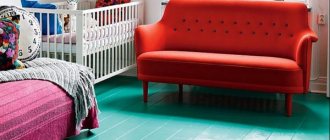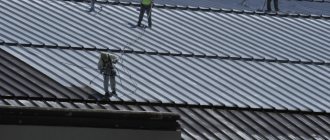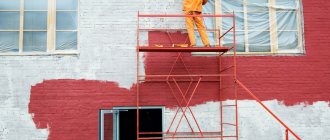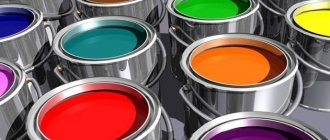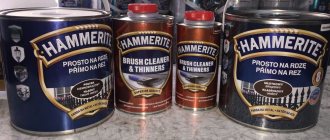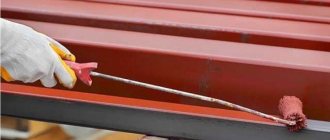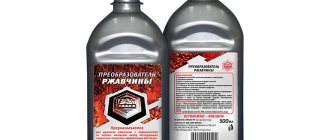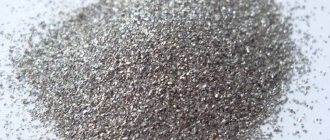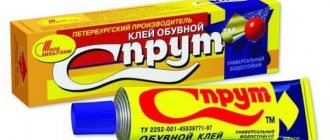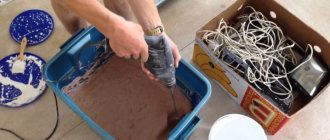Before use, metal products require not only decorative finishing, but also protection from the formation and spread of corrosion. For these purposes, rust paint is used. As is known, such a process develops during the reaction of iron with oxygen in the presence of water or moist air. Special compounds block moisture from entering the metal, resulting in the top layer not being destroyed. Today the market offers a large selection of goods, and in this article we will look at which products have earned the most positive reviews and why.
Category
Name
Price
a brief description of
Best anti-rust paint for exterior metal work
Contains alkyd resin and fatty acids. They block corrosion 100% and can be applied directly to damaged areas. Gives 8 years of protection.
At a low price, it perfectly neutralizes rust. Very toxic, use only outside.
The best paint for rust 3 in 1
Decorative enamel with hammer effect. Very durable, almost odorless. Dries quickly - no more than an hour between coats.
Very high quality, three-component. Apply immediately, without prior preparation. For maximum effect you need 2-3 layers.
Inexpensive, but protects well. On average it lasts 10 years. The smell is pungent and dissipates quickly. Apply using standard methods.
The best anti-rust paint for a car
Available in aerosol cans. Cold galvanizing effect. Very high quality protection.
520 ml – 200 rub.
Notable for its wide range of colors and easy to apply. It should be covered within a year.
Features and Specifications
Anti-rust paint for metal, due to its characteristics, has many advantages. Based on user reviews, a list of the most significant advantages was determined:
- metal and rust paint can be applied directly to existing corrosion;
- the product creates a reliable protective layer on the surface of the base that can repel dirt, dust, and moisture;
- the material has increased covering ability and good adhesion;
- the product provides long-term anti-corrosion protection;
- The products are available in various shades and are able to dry quickly.
Despite a fairly large list of advantages, the material also has disadvantages. The main disadvantage of metal and rust products for external as well as internal work is the inability to process structures that are subsequently exposed to high temperatures of more than 150°C. Contact of painted objects with food or drinking water is also strictly prohibited.
The market for paint compositions offers several options for rust mixtures, varying in composition and properties:
Epoxy products are not recommended for use due to increased toxicity, oil products have low resistance to temperature changes, and the alkyd version should be used on structures that are not subject to heat; in this case, an acrylic mixture is suitable. Using hammer products, it is possible to obtain a rough coating with a metallic sheen.
What is rust?
Low corrosion resistance can become a source of big problems. It not only worsens the appearance, but also reduces the service life of structures and products. Rust occurs as a result of oxidative processes occurring on the surface of the metal. To start the process, moisture alone is not enough; air also participates in it. One of the conditions is a large amount of water vapor.
Subsequently, corrosion penetrates deep into the material. The porous structure of the metal acts as a favorable environment for the accumulation of moisture. In order to develop optimal ways to combat corrosion, you need to understand what it is like:
- From exposure to atmospheric phenomena. Humid air and other negative factors lead to the onset of oxygen or hydrogen depolarization, which destroys the crystalline molecular lattice.
- Water (sea). The material is negatively affected by salts and microorganisms.
- Unpaved. Soil temperature, composition and other factors have a significant impact. Since this mainly concerns pipelines, early diagnosis is problematic.
Depending on the type of lesion, several types can be distinguished:
- rust has affected the entire surface or individual sections of it;
- spots penetrating pointwise;
- a deep crack that destroys the molecular lattice;
- in a steel product consisting of several alloys, damage to one of them;
- an extensive lesion that deforms the surface and penetrates deep into the material.
Classic protection consists of removing the affected area and treating it with anti-corrosion primer. Afterwards they are painted with protective paint. This technique requires significant material costs from the performer, and implementation takes a lot of time. In this regard, the search for alternative methods that would require less time and money did not stop; they became paints used over rust.
Best anti-rust paint for exterior metal work
Paints and varnishes perform protective functions by mechanically isolating the treated metal from the environment. The main condition is the preservation of characteristics during temperature peaks, 100% coverage of the base and resistance to mechanical loads.
Hammerite
Rust paint for exterior use is more of a universal product, since it is successfully used indoors and outdoors. The product is applied to unpainted as well as painted surfaces that consist of ferrous metal alloys. The special 3-in-1 formula includes a topcoat, primer and corrosion inhibitor, which significantly reduces base preparation time.
As a result of using Hammerite, a reliable wear-resistant coating is obtained that is not subject to deformation when exposed to moisture and temperatures. The material dries relatively quickly, and subsequent application is possible after 4-6 hours. The alkyd product can be used in domestic conditions, industrial facilities, warehouses and even for roofing, if necessary.
Suitable paint for fences, pipeline systems, furniture. The base can be wood, metal, plastic, or corrosion. The material is applied using a spray gun or brush. Mechanized application is also possible. After complete drying, the coating for interior and exterior work acquires a glossy shine. Washable Hammerite dries in 4-6 hours in an optimal environment. The price for a 2.5 liter container is 2500 rubles.
Prestige Primer-enamel
Economical paint for roofs against rust, as well as other metal structures, has a low consumption - 60-120 g/m2. It takes up to 40 minutes to dry, which is a big undeniable advantage.
It is possible to use xylene, R-4, R-5 as a solvent. The material has an anti-corrosion effect and a high level of resistance to various aggressive influences. Paint is used for galvanized roofs, fences, and pipeline systems. The price for a 1 liter container is 250 rubles.
Recommendations
To get the maximum result from your purchase and enhance its qualities, as well as to fully understand the benefits of the mixture, it is recommended to listen to the simple advice of experts. They can increase the effectiveness of the paint and varnish mixture.
- Before making a purchase, carefully study the instructions. In some cases, special solvents may be required. In this case, immediately purchase additional products and strictly follow the instructions.
- Certain mixtures position themselves as 3 in 1. But, if time permits, additional funds will not be superfluous.
- Only the manufactured structure is painted after the metal has completely cooled. Then they clean the seams and then proceed to the final stage.
- Carry out external work taking into account the temperature (over 27 degrees - postponed). Likewise if it is too low. Since the dye will quickly harden and will not be able to fully affect the material.
- Despite the fact that the instructions indicate the possibility of application to an unprepared surface. Experts recommend preparing and degreasing it. In this case, the paint will react more effectively and the result will be better.
The best paint for rust 3 in 1
If the can says “3 in 1”, this means that when applied, the main tasks will be performed - priming the surface, converting rust and creating a monolithic layer of enamel. Such compositions are resistant not only to water, but to mineral oils and chemical reagents.
Read also: Phoenix engine oil 5w40
Lacra Hammer Effect
This is a cheap hammer paint made on the basis of alkyd-styrene resin. Performs simultaneously the function of protection against corrosion and a decorative mixture. Used for processing clean metal structures with rust up to 0.1 mm, as well as wood surfaces.
Lacra Hammer Effect
The hammer consistency, when completely dry, creates a glossy finish with a hammered pattern. It should be remembered that the use of the mixture for non-ferrous metals is possible only after applying a primer. A glossy surface can be created using a roller, brush, or spray gun. The price for a container of 0.8 kg is 405 rubles.
Alpina Direkt Auf Rost
Alpina paint is intended for interior and exterior work on metal products. The material simultaneously acts as an antiseptic against corrosion, primer, and decorative dirt. It is allowed to use brushes or rollers. The material is produced in different colors.
Alpina Direkt Auf Rost
In the manufacturer's catalog, the buyer will find paint in the following colors:
3 in 1 rust products are packaged in 2.5 liter tin buckets. One liter will be enough to treat 12 m2. The cost of 3 in 1 paint for rust varies between 1900-2000 rubles.
Stop Rust XB-0278 6617
Primer enamel is used for processing metal structures exposed to weathering. Suitable for coating products made of cast iron and steel materials that are already corroded or have remnants from previous coating. The mixture is able to penetrate formations and block their further spread. The product combines three main properties - decorative, anti-corrosion, protective.
Owners of old or used cars are often faced with the need to paint a rusty body. Previously, such work was a very lengthy process, and painting did not solve the problem of corrosion. Now there are special materials on sale that simultaneously perform both protective and aesthetic functions.
What are the differences from the usual ones?
Surface treatment, which includes several stages, takes an unreasonably long time and requires additional cash injections. Rust paints are applied directly to the spot, just like regular decorative paints. They have a wide color palette.
As a rule, such paint on the packaging is marked 3 in 1, indicating that three tasks are performed.
- Eliminates rust.
- Primes the surface.
- Forms a monolithic decorative waterproof layer that is resistant to various chemical influences.
Advantages:
- application to a surface covered with rust does not require complete cleaning;
- anti-corrosion resistance;
- the formed layer protects from dirt and water, with it the metal product has an attractive appearance;
- good adhesion to the affected areas, create a uniform coating;
- dries quickly;
- retains its qualities for 8 years. The timing varies depending on the composition and manufacturer;
- wide color palette.
Flaws:
- use on structures heated above 150 degrees is not allowed;
- It is strictly forbidden to paint products that come into contact with drinking water.
Properties and purpose
This paint coating can even be applied to rusty areas of metal. Before painting, it is enough to sand the desired area. This product can protect the car from the spread of corrosion and create a water-repellent layer.
The product dries quickly, lasts a long time and has a wide palette of colors. There are aerosol and regular paints. An aerosol is convenient for painting hard-to-reach areas, and paint in a standard consistency can be used to treat large areas of a car.
Oxidized or raven metal
If you ask any man what the dark coating of a pistol or machine gun is called, he will immediately answer - “blueing”. Indeed, the black or bluish color of the weapon resembles the color of the feathers of a crow, which is where it got its name.
This coating is also called oxidation or blackening. Surprisingly, the black protective layer is made up of oxides, chemically similar to rust. Their protective properties are provided by their high density and ordered structure.
Blueing is a fairly popular method of protection. In addition to weapons, a variety of parts and tools are also subjected. In particular, the popular self-tapping screws also received a black color due to oxidation.
Choice of composition and form
In order for the coating to cope with its task, you need to study its composition and capabilities. Now there are several types of compositions:
- the use of alkyd resins makes the material inexpensive, but of high quality; such paint can be used on an unprepared area;
- paints with acrylic polymers have almost no odor, you can work with them indoors, the downside is that the surface under them must be primed;
- mixtures containing polyurethane materials are highly resistant, but can only be used outdoors.
Based on these indicators, you need to select material for your purposes.
What are they?
Metal is actively used in all areas and industries. Depending on the type of activity, specific compositions have been developed. It is customary to classify anti-corrosion compounds according to one element:
Alkyd
A budget option that is in high demand. Alkyd enamel is made on the basis of the varnish of the same name or synthetic resins. The main area of application is painting galvanized metal surfaces.
Dignity:
- does not require much time to dry;
- operation for many years;
- aggressive chemicals and temperature changes do not cause harm;
- ease of use and low consumption.
Flaws:
- carry out work only in a protective respirator, special clothing and a mask;
- are highly flammable, use in rooms and highly heated metal structures is not allowed;
- high adhesion properties.
Acrylic
The basis is polyacrylates, dyes and anti-corrosion modifiers. A universal composition for use indoors and outdoors.
Advantages:
- the dense inert layer is not afraid of temperature fluctuations and atmospheric phenomena;
- acrylic adapts to the tension and compression of metal;
- incombustible;
- has no odor or harmful compounds. Used inside buildings;
- does not fade;
- The use of colors is allowed.
Flaws:
- clean and dry surface without dust and dirt;
- Humidity and air temperature must correspond to the manufacturer's recommendations.
Oily
Natural oils and drying oil were used in production. The resulting enamel is practically unstable to negative atmospheric conditions, ultraviolet radiation, temperature changes and rust. In this regard, they are painted only in buildings.
Hammer
The polymer resins included in the paint provide high adhesion to metal. The resulting coating is strong and will last for several years. Forms a rough layer with a characteristic shine.
Advantages:
- not afraid of high humidity and temperature changes;
- does not fade;
- resistance to mechanical damage;
- heat resistance.
Flaws:
- high price;
- problems with removing the old layer;
- high consumption.
Epoxy
Enamel that enjoys high popularity and popular recognition. The composition includes epoxy resins, coloring pigments and hardeners. The main scope of application is painting external elements.
Advantages:
- dries within 4 - 10 hours;
- glossy finish;
- resistance to high temperatures;
- affordable price.
Flaws:
- toxicity.
Examples of popular brands
There are a huge number of manufacturers of such goods on the market, but the following products are the most popular:
- "Nerjamet". Consists of resins, polymers, organic solvents. Can be applied even to an unprepared surface. Recommended for use as a topcoat.
- "Novbytkhim". It is very popular, but cannot be applied to surfaces painted with nitro-based material.
It deserves special attention because it can be used not only on various metals, but also on wood and concrete. Eliminates and prevents rust, protects against aggressive environmental factors. Cons: strong persistent smell, limited palette.
To achieve the desired result, you need to choose the right composition of the product. Many products can boast of their versatility and are used at all stages of car transformation.
*Review of the best according to the editors of expertology.ru. About the selection criteria. This material is subjective in nature, does not constitute advertising and does not serve as a purchase guide. Before purchasing, consultation with a specialist is required.
Metal is a durable building material that can be formed into various designs. It is used as a frame for houses, door frames, furniture and stairs. In the courtyard of a private house you can often find iron gates, a fence, or a garage. The only drawback of the material is oxidation upon contact with moisture, as a result of which carbon steel rusts. We present to you a rating of the best metal paints that have high adhesion to solid materials and form a durable protective film. The products were selected by analyzing the characteristics of our experts and taking into account the opinions of customers in reviews.
How to paint rusty metal: choice of materials
Metal is a strong and durable material.
Its enemy is rust, which can completely destroy products made from it.
The answer to the question of how to paint rusty metal is essential in order to keep iron structures in working condition for as long as possible.
Stages of processing metal products
Rusty metal product
The main causes of rust are interaction with oxygen contained in the air and constant contact with moisture.
This process goes very quickly, sometimes a few days are enough for a new product to become covered with rusty spots.
Regular inspection and painting of such objects can promptly prevent the spread of rust over the metal surface.
Preparation for applying paint is a rather labor-intensive process, consisting of several stages:
- removing old paint
- rust removal
- degreasing the area to be painted
- applying primer
- selection and application of suitable paint
If preparation is carried out in violation of technology and ignoring basic requirements, then this will significantly affect the final result. To get the maximum effect, it is also important to consider:
- size of area damaged by corrosion
- degree of damage
- location of the item that needs processing
- how complex is the shape of this object?
- financial opportunities to purchase the necessary tools and materials
Removing old paint and rust
To remove old paintwork, you can use a scraper, a wire brush, or sandpaper. If it doesn't hold well, then even a metal sponge for cleaning pans will do. When these methods do not give the desired result, high temperatures should be used.
To create them, a hair dryer or a gas torch is suitable. After this, it will be easy to get rid of the swollen and burst paint.
Removing rust is not that easy. This can be done both by mechanical action on the surface and by using chemical compounds. Here are some ways:
- Metal brush, spatula, sandpaper - an old, well-known method. It is practical only in places where it is easy to penetrate and where the layer affected by corrosion can be easily removed.
- A special drill attachment will greatly simplify the work.
- A core brush and a petal wheel for an angle grinder are an effective method when the area of damaged metal is small and has a flat shape.
- The sandblasting installation allows you to remove rust even 15 years ago. Using this unit, you can clean a large area of metal surface in a matter of minutes and without much effort, even in the most difficult to reach places.
- Citric acid is used if the product has not been painted and can be immersed in citric acid for 24 hours. There is another option for working with this compound: treat the surface with it, and then cover it with plastic film and secure it so that it does not slip. This method helps even with a thick layer of rust and in places where mechanical methods do not help.
If you apply table vinegar with a sponge to the treated area and rinse, you can easily remove a thin layer of rust.
- To get rid of a thick layer of rusty deposits, phosphoric acid is applied to the metal structure with a brush or spray. It is left for 12 hours, then washed off with soapy water. Extreme care must be taken to ensure that acidic agents do not get on the face, hands, or eyes when working in rubber gloves and safety glasses.
- Rust converters have appeared relatively recently. They usually take the form of an emulsion or suspension, which is applied for several hours after removing the exfoliated layer. It reacts with rust to form insoluble iron phosphate. Then the iron salts are washed off with plenty of water.
It is especially important to thoroughly clean those places where rust forms several layers and falls off in pieces.
Degreasing and priming
Primer for metal
Degreasing is carried out using gasoline, acetone, and turpentine.
Using a brush, roller or spray, they treat the metal surface.
Then wash it off using a piece of rag.
A concentrated soap solution or diluted detergent will also work.
After this, you need to wait until the surface is completely dry.
The primer is used to close pores and cracks and make the surface smoother.
It also ensures good paint adhesion to the metal.
When choosing a primer, you should take into account that some of its types are highly specialized, intended for use only with certain types of paints, while others are universal and suitable for almost all types of paint.
The following discusses several types of primers and their features:
- GF-021 is a gray liquid. It is diluted with a solvent. Its main function is to remove traces of corrosion. It can be used without subsequent treatment with any paint. It takes 12 hours to dry completely. It is characterized by low heat resistance - can withstand temperatures up to 60 degrees.
- Primer GF-031 ideally protects against corrosion. She is not afraid of high temperatures (up to 200 degrees). It is based on glypthal varnish. It has a yellow color. For dilution, it is recommended to use xylene and solvents (for example, RS-2, RKB-1). This primer is of such high quality that it is used in the aircraft industry for coating surfaces. It is sold at retail; the price is affordable.
- The VL-02 primer mixture contains orthophosphoric acid, which, by destroying metal particles, creates a continuous film. Its basis is polyvinbutyral. For dilution immediately before use, solvents R-6, 648 and RFG are used. It dries in record time - in just 20 minutes at a temperature of + 22° C. It is compatible with almost all enamels and organic solvent paints. It is especially good for processing galvanized metal, aluminum, and stainless steel.
- The composition of the AU-1417R primer suspension includes pigments, urethane and a rust converter. The presence of the latter allows you to process black steel without first cleaning the rusty metal. Urethane is a chemical widely used in the production of polyurethane foam. It ensures a high degree of adhesion of this primer to the metal. Thanks to the pigments, you can choose the appropriate color and use AU-1417R as the main paint. Then it is applied in several stages. It is important to wait until each layer is completely dry. This suspension also combines well with polyurethane enamels.
It is advisable to use a brush or roller when applying the primer. The sprayer does not always provide 100% closure of all grooves and cracks, especially if the surface of the object has a highly porous structure.
Paint selection
After priming, painting is carried out in the main color. When choosing what to paint rusty metal on the street, it is important to consider the basis of the materials. It must be compatible with the previously applied primer layer.
If such a layer is missing, then choose such coloring agents that simultaneously solve the problem of rust and provide the required shade of the product. Such materials contain polymer components that neutralize the oxidative process.
Phosphoric acid, often used for this purpose, eats away rust. It acts where traces of corrosion could not be removed and protects the metal.
Under the influence of such paints, a continuous film is formed that does not allow air and moisture to pass through. This prevents rust from forming.
Paints offered on the market can be divided into ordinary enamels, acrylic (soluble and insoluble in water), created on the basis of epoxy resins, and alkyd.
Types of paints
Acrylic paints are diluted only with water. They are considered combination paints because they combine three processes (surface stripping, priming and painting) into one. Apply them directly to rusty metal.
Their composition is unique in that it neutralizes rust, protects the metal from future corrosion and gives a beautiful appearance. The cost of these paints is quite high.
Their advantages include:
- No need to clean off rust.
- Long service life of painted surfaces subject to all technological requirements.
- No microcracks under mechanical loads.
- Dilution with water does not cause significant environmental damage.
- Easy to use.
- Can be used for both external and internal work, including in rooms with high humidity.
A distinctive feature of such paints is their good adhesion to the metal, even if there are remnants of a previously applied layer. They are mixed and applied to a degreased metal surface.
Any device for painting work can be used as a tool. They are based on water, so they must also be diluted with water.
Paints created on the basis of epoxy resins are called organo-thinned and two-component. They can also remove rust. As the name suggests, they have two components: a base and a hardener.
Epoxy resins create a strong insulating film. Hardener is sold separately.
The quality of painting depends on the proportion in which these two components are mixed. Usually the hardener is no more than 10%. More precise instructions are provided on the packaging of each product.
If necessary, these paints and varnishes are diluted with special active thinners. Drying time ranges from 4 to 10 hours. These paints offer a wide range of colors and are attractively priced.
Alkyd paints and enamels are sold ready-to-use. They are based on artificial alkyd resins and organic solvents. After complete drying, the surface becomes glossy. If the paint is a bit thick, you can use white spirit or turpentine to thin it.
It is easy to use and makes it possible to paint large areas in a short time. After drying, it forms a hard film of fairly significant thickness, which prevents the influence of environmental factors. It provides a variety of colors. Its disadvantage is severe toxicity.
Water-dispersed compositions save money. Paints with anti-corrosion additives and rust converters are more expensive, but they save effort and time on cleaning the surface. In addition, they create a durable, elastic coating that remains unchanged over time.
Painting process
How to paint a metal fence
When painting metal products, you need to take into account that the temperature of such a surface, heated by the sun, can be much higher than the ambient temperature.
Painting heated products can lead to unwanted defects.
In summer, it is recommended to carry out such work in the morning.
On the other hand, painting wet, damp or condensation-covered surfaces is unacceptable.
Fog also creates excess humidity. The weather during the painting process of metal products located outdoors should be dry.
To apply paint you can use the following tools:
- Using paint brushes (care must be taken to ensure that streaks, streaks and drops do not form; a good method for products with complex shapes).
- Using rollers (preferably 30 cm in length; moving the roller from top to bottom, you need to overlap the strips).
- Spray paint sprayer (the most economical option).
One-time painting rarely gives the expected result. Usually it is necessary to make 2-3 layers, sometimes four or more. Allow at least 3 hours for the paint to cure before applying the next coat.
Painting rusty surfaces in a cellar
When deciding how to paint rusty metal in a cellar, you need to be guided by the same principles as for the street, and choose from the same materials. The following must be taken into account:
What kind of ventilation is there in the cellar?
Converter dyes contain concentrated acid. When inhaled, it damages the mucous membranes of the respiratory tract. These chemical burns are difficult to treat. To avoid harm to health, you need to create good ventilation.
In those cellars where this is not possible, a respirator should be worn when working with chemicals. This creates inconvenience during work, but protects the respiratory system.
There is another way: choose paints and varnishes without a rust converter in their composition. Then it is necessary to reduce the painting time as much as possible due to the toxicity of such materials and the lack of protection for the mouth and nose.
How dry is the surface?
The question is not out of place, since the humidity in the cellar is usually significantly increased. It is not recommended to use special rust converters here, because they are washed off with water and the surface then has to be dried for a long time.
It is better to resort to mechanical cleaning methods if the shape and size of the object allows.
Is it possible to dry the surface naturally?
In deep cellars, condensation forms on any surface. Sometimes there is standing water in them. Then the metal products must be dried. Various types of heaters are suitable for this.
A hairdryer will also come in handy. In summer, the doors and exhaust vent are additionally opened to speed up the process.
Treating metal surfaces damaged by rust is not an easy task. To achieve the result, you need to clean, prime and paint the product or use special combined coloring agents that combine all these stages.
How to paint a water barrel is shown in the video:
Select it and press Ctrl+Enter to let us know.
How to choose paint for metal
When choosing paint for metal, many people think only about its color, unaware of the existence of important characteristics that affect the application process and subsequent operation. Here are the main parameters that you should pay attention to when choosing enamel for metal structures:
- Application temperature
. In order for the paint to adhere easily to the metal and spread evenly, a suitable ambient temperature is required. For some compounds it is +10 degrees, and for others from +1, which expands the possibilities for use for street work in the cool season. - Operating temperature
. After hardening, the paint layer retains its color without yellowing up to a certain temperature. For alkyd paints the indicator is 80 degrees, for acrylic paints 120 degrees, and for polyurethane paints up to 150 degrees. - Dilution
. Water-soluble paints require water to prepare for use and do not emit an unpleasant odor. Diluting with a solvent slightly increases the cost of painting per square meter and is more toxic at the time of application. - Surface requirement
. Some types of enamel need to be applied only to a cleaned and degreased surface, others are allowed to be painted even over rust. This is achieved through special substances in the composition that transform existing corrosion and stop it. - Drying time
. The indicator varies from 5 to 12 hours and affects the duration of the work and the commissioning of the structure. - Method of application
. Some products are suitable for brushes, which is practical in the case of a small area to be painted and a complex contour of the product. Other enamels can be applied by roller or spray, and this speeds up the process and is optimal for large and even structures. - Covering power
. Costs depend on the consumption of coloring material. Covering capacity can range from 7 to 13 m² per liter. - Gloss level
. In addition to paint color, there is a degree of gloss, where there are matte, semi-matte, glossy, semi-gloss options. All this in its own way affects the appearance of the parts being painted.
Read also: They bought me a new phone
How to paint metal so it doesn't rust
In every home, among household utensils and interior items, there are materials, tools or parts made of metal. They are practical, wear-resistant, but sooner or later they corrode. How to prevent this process? How to treat metal so that it does not rust?
Painting metal for rust: main rules
One of the main conditions for high-quality painting, including anti-corrosion painting, is careful preparation of the surface for coating. But it is not always possible to clean and prepare a metal surface covered with a layer of rust. There are special paints and varnishes that can be painted without removing the rusty layer of metal.
Rusting of metals
Metal structures are subject to rust, and these processes occur in stages, chemical reactions flow into one another.
Prerequisites and conditions for the start of the rusting process: the metal contains certain impurities (carbon and sulfur), oxygen and water have access to the surface.
Carbon and sulfur, which are included in the composition of steels as additives, act as corrosion enhancers - the layer of formed rust is destroyed, a new layer of metal is exposed, and the process continues.
If there is an acidic environment and/or salts are present, the rusting process will accelerate even more. Acidity is increased by substances contained in atmospheric water - sulfurous and carbonate acid. Water causes corrosion of unprotected metal surfaces, regardless of their state of aggregation - in the form of vapor, liquid phase or ice.
When metals rust, the resulting layer of rust does not protect the surface, as in the case of passivation (creating a protective film on metals) and cannot prevent subsequent corrosion.
Rust has a loose and hygroscopic structure, instantly accumulates moisture from the air and retains it.
As a consequence, if rusting has begun, the growth of rusty layers accelerates oxidative processes for two reasons: the relative thickness of the metal decreases and the duration of contact with moisture and oxygen increases.
In ordinary cases, painting metals over a layer of rust makes no sense. Moisture and air have accumulated in the pores of the loose structure, which are sufficient to continue the processes of destruction of metals under the paint layer.
In addition, rust cannot be compared to steel in terms of density; it is a weak and loose layer, and as a result, a stress zone forms under the paint layer - expansion of the corroded metal.
